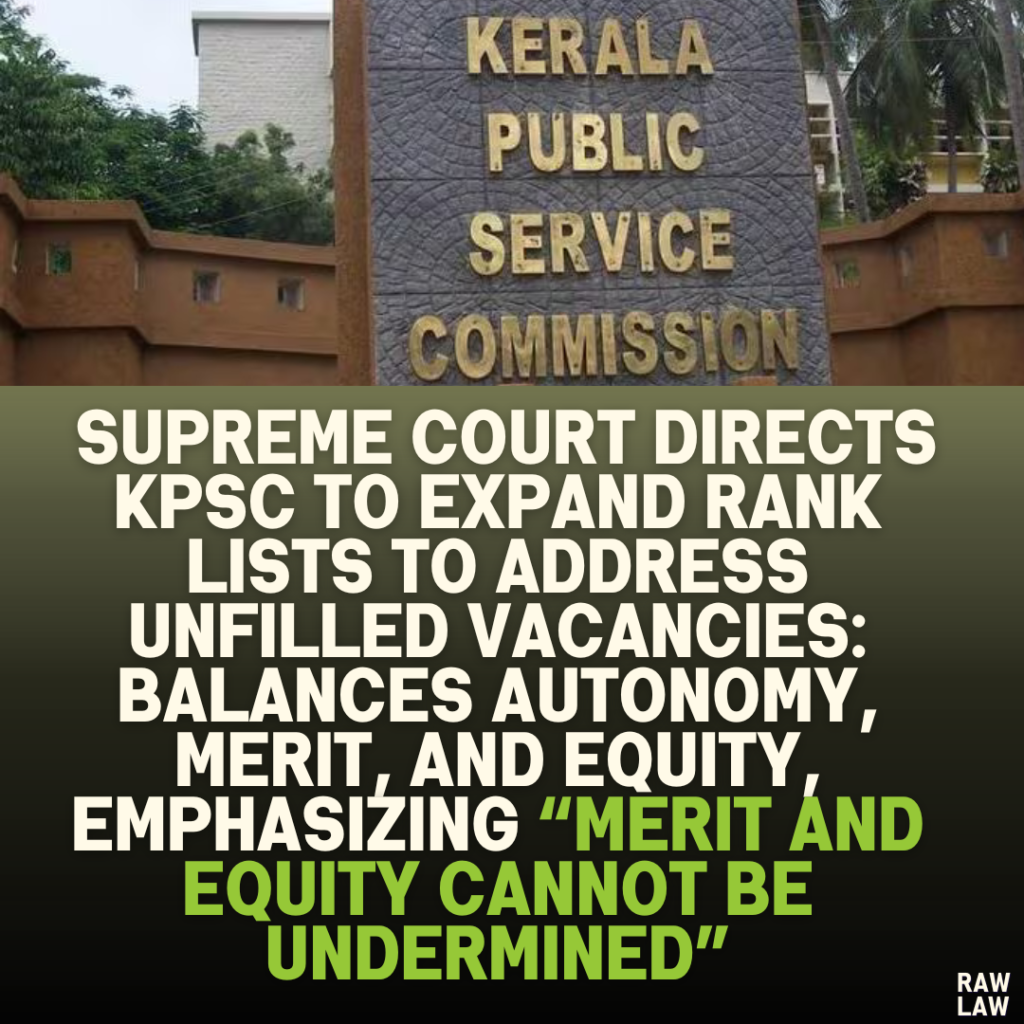Court’s Decision
The Supreme Court allowed the appeals filed by candidates affected by KPSC’s refusal to expand its rank lists. It directed KPSC to include additional vacancies identified by the State Government under the 2014 notification for Junior Health Inspector Grade-II posts. The Court reasoned that failing to address these vacancies would undermine fairness, equity, and the principles of merit-based public employment. KPSC was instructed to act promptly to facilitate the inclusion of all eligible candidates, noting the extraordinary administrative circumstances that contributed to unfilled vacancies.
Key Quote:
“Ensuring that qualified candidates are given their due opportunity is both an equitable and constitutionally sound approach.”
Facts
- Recruitment Process:
- KPSC issued two notifications in 2014 and 2015 for Junior Health Inspector Grade-II posts across different districts in Kerala.
- Rank lists were published in 2020 and remained valid until February 2023.
- Candidates faced challenges due to overlapping names in multiple rank lists and delays in recruitment.
- Administrative Lapses:
- Despite clear instructions in the 2014 notification that vacancies arising in the future would be considered, KPSC limited its list to initially reported vacancies.
- The State Government identified additional vacancies and recommended expanding the rank lists to fill them, but KPSC refused.
- Tribunal and High Court Rulings:
- The Kerala Administrative Tribunal (KAT) and the High Court upheld KPSC’s autonomy and declined to interfere with its decisions regarding the rank lists.
- Present Appeal:
- Aggrieved candidates argued that KPSC’s refusal deprived them of legitimate opportunities and approached the Supreme Court.
Issues
The primary legal questions addressed by the Court were:
- Can KPSC refuse to expand the rank list despite the State Government’s recommendation?
- Does KPSC’s autonomy extend to determining workforce requirements?
- Are qualified candidates entitled to claim vacancies that arose due to administrative lapses?
Petitioner’s Arguments
- Extraordinary Circumstances:
- Overlapping rank lists and procedural inefficiencies led to numerous unfilled vacancies.
- Government’s Role:
- As the employer, the State Government’s recommendations regarding vacancies are binding on KPSC.
- Violation of Equity:
- Denying qualified candidates their rightful appointments contradicts constitutional principles of fairness and merit-based employment.
- Prolonged Recruitment:
- Candidates had waited nearly a decade for the selection process to conclude.
Respondent’s Arguments (KPSC)
- Autonomy:
- KPSC emphasized its constitutional autonomy as an independent body, arguing that interference would undermine its authority.
- Negative Precedent:
- Expanding the rank lists post-validity could lead to future demands for similar actions, disrupting recruitment processes.
- Validity of Rank Lists:
- The rank lists were prepared considering vacancies reported at the time and had expired, making any expansion untenable.
Analysis of the Law
- Division of Roles:
- The Court clarified that determining workforce requirements and vacancies is the prerogative of the Government, while KPSC’s role is confined to conducting a fair and transparent selection process.
- KPSC’s Overreach:
- By refusing to expand the rank list despite Government directives, KPSC exceeded its mandate and undermined the recruitment process.
- Extraordinary Circumstances:
- The Court recognized the unique administrative challenges in the case, such as overlapping rank lists, and emphasized that such issues required equitable solutions.
Precedent Analysis
The Court referred to earlier judgments emphasizing the autonomy of public service commissions but highlighted that such autonomy must align with principles of equity and fairness. The Court underscored that judicial intervention is warranted when administrative lapses or inequities affect merit-based recruitment.
Court’s Reasoning
- Balance of Power:
- While KPSC is an autonomous body, its autonomy is limited to the selection process. Determining vacancies is the Government’s role.
- Merit and Equity:
- Excluding qualified candidates due to administrative inefficiencies undermines the principles of fairness and merit.
- Addressing Administrative Lapses:
- The overlapping of names in rank lists and delayed recruitment caused inequities, necessitating remedial action.
- Impact on Governance:
- Unfilled vacancies disrupt public administration and service delivery, making the Government’s recommendations imperative.
Conclusion
The Supreme Court set aside the High Court’s judgment and directed KPSC to expand the rank lists. It emphasized that public recruitment processes must balance autonomy with fairness and equity. The Court directed KPSC to fill all additional vacancies identified by the State Government from the existing rank lists without further delay.
Implications
- Public Employment:
- The judgment reinforces the importance of merit and equity in public recruitment.
- Administrative Accountability:
- It highlights the need for clear coordination between the Government and public service commissions to avoid similar lapses in the future.
- Candidate Rights:
- The decision safeguards the rights of meritorious candidates, ensuring they are not penalized for procedural inefficiencies.




Pingback: Bombay High Court Partially Overturns Convictions in ₹2.36 Crore Cash Van Robbery: Highlights Investigative Lapses and Procedural Violations, Orders Further Probe - Raw Law